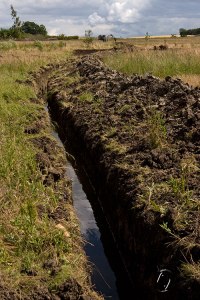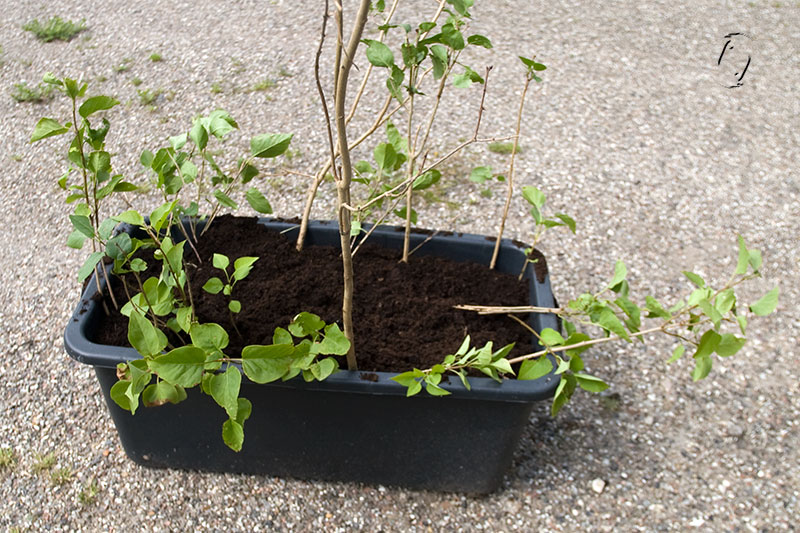Deep ocean
.
Came across a patch of flowers in the forest the other day that turns out to be a garden plant by the name of Telekia speciosa, heartleaf oxeye.
Normally I don’t blog on Saturdays, figuring I’ll give you people a rest from my blabbing, but I wanted to get this one out of the queue, so here you go.
Continue reading “Telekia – tusindstrÃ¥le”
For a few years one end of our property (and the neighbours’) have been flooded in winter due to clogged drains in the fields. Most have been fixed, but eventually most of our hedges way up in the garden died because they were standing with their feet in the water followed by two very frosty winters.
So this summer we’re working on a new drain all the way from the garden to the low end of the farm where the big new drain is running. No point in getting a new hedge if the garden is a swamp 6 months out of 12! But the garden is much too windy without one. A hedge that is.
 It’ll probably be a couple of years (they say) before we see the actual effect, so in the mean time I’ve decided to make new hedges, using what we already have, spiraea and ribes. For the lilacs I’ll have to see if any of them have sent out shoots that I can dig up and nurse a bit in a pot. I think I’m a bit late in the season to use cuttings?
It’ll probably be a couple of years (they say) before we see the actual effect, so in the mean time I’ve decided to make new hedges, using what we already have, spiraea and ribes. For the lilacs I’ll have to see if any of them have sent out shoots that I can dig up and nurse a bit in a pot. I think I’m a bit late in the season to use cuttings?
Now only remains to be seen if I can actually remember to nurse them all through the winter…. At least if we don’t get frost, I have a self-watering greenhouse!
.

Summer being what it is this year (sweater weather – ooops, I said it again) and my plastic greenhouse falling apart from exposure (let’s just say I don’t need to air it out when it’s sunny OR water my plants, that all happens naturally), I’m going to see if our kitchen window gets hot enough for some solar dyeing experiments. A south window would be better, but the cats use those and they’re not very particular about what they shove out of the way. So east it is. Here’s a couple of pix of my preparations:
Last year I scraped off a teeny amount of lichen from some dead trees. Thinking it might be the parmawossname saxatilis? that yields blue which then sometimes turns to pink when exposed to sunlight. Soaked it in ammonia and it looked pretty brown for a long time until I forgot about it. It’s been sitting in the greenhouse all winter, until I found the bucket again yesterday. Inside was a clear blue liquid (much like that blue toilet water you see someplaces) and the plant matter just some black fluff at the bottom. In went some fleece and the day after it looked like this:
I have no idea if this is lichen dyed or ammonia dyed… It doesn’t turn pink in the sun anyway or change when soaked in vinegar.
I have further plans for cold dyeing:
I’ve been pondering whether the jars would get hotter and the colours preserved better in coloured jars. Which colour would work best I wonder, green, red, black? One could cover the glass jars in coloured cellophane, that would make it easy to check on the progress.
This is an excellent blog on the subject that someone posted on Ravelry.
Dre has had a lot of scientific thoughts on the subject
â Leave a Comment
Min plan omkring solfarvning – dvs. koldt vand som sÃ¥ blot opvarmes via solen i xx dage eller uger istedet for at koge planter og uld – holder ikke helt stik pga vores meget kolde sommer OG fordi mit Lidl plastdrivhus er ved at falde fra hinanden, betrækket kan simpelthen ikke holde til vind og vejr, sÃ¥ alle de smÃ¥ “ruder” er ved at falde ud. Dvs. jeg ikke kan fÃ¥ temperaturen i mine farveglas op, pÃ¥ den anden side behøver jeg hverken luft ud derinde eller vande planter, det klarer naturen selv….
Men nu prøver jeg alligevel et par bøtter i køkkenvinduet, noget silke, noget Dorset, et par bomuldsblondepynteting proppet i vand med egeblade som en slags bejdsning, perikumn i vodka, fordi jeg ikke har fundet blomster nok til at farve en ordentlig mængde uld med, men noget skulle der ske. Og så et par bøtter med syrefarverester. Enten er varmen nok på sigt til at klare vandet = farven sidder på ulden, eller også damper jeg det til sidst hvis det ikke virker. På den måde regner jeg med efterhånden at få regnbuefarvet en del af den Suffolkham som jeg fik gratis hos min høleverandør.
De der 40 + grader man kan få i et drivhus kommer jeg nok ikke op på selvom sylteglassene måske nok i sig selv gør lidt. Det gule glas med gåseurt var i hvert fald håndlunt da jeg mærkede efter, men ikke så varmt at mit termometer kunne vise noget.
Woad generates about a ton of seeds per plant, I harvested a whole sack, forgot about it, they moulded and I went out and got another batch to boil directly for trying to dye with as instructed in “Wild Color” by Jenny Dean.
The dyebath was dark, dark and looked suspiciously like an actual woad dye bath, so I couldn’t resist trying a small portion out treating it as such. Alkaline, whisking, spectralite etc. Result:
To the rest, dark brown soup, I added some unmordanted fleece (yeees, more of that Dorset), which after a good heating up looks like this: Continue reading “Woad seed dyeing”